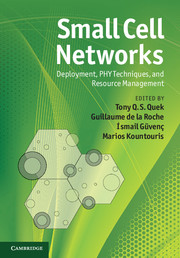Book contents
- Frontmatter
- Contents
- List of contributors
- Foreword by David Chambers
- Acknowledgments
- Acronyms
- 1 Small cell networks overview
- 2 Fundamentals of access control in femtocells
- 3 Coverage analysis using the Poisson point process model
- 4 Interference modeling for cognitive femtocells
- 5 Multiple antenna techniques in small cell networks
- 6 Physical layer techniques for cognitive femtocells
- 7 Femtocell coverage optimization
- 8 Random matrix methods for cooperation in small cell networks
- 9 Mobility in small cell networks
- 10 Cognitive radio resource management in autonomous femtocell networks
- 11 Decentralized reinforcement learning techniques for interference management in heterogeneous networks
- 12 Resource allocation optimization in heterogeneous wireless networks
- 13 New strategies for femto-macro cellular interference control
- 14 Femtocell interference control in standardization
- 15 Spectrum assignment and fairness in femtocell networks
- 16 Self-organization and interference avoidance for LTE femtocells
- Index
- References
12 - Resource allocation optimization in heterogeneous wireless networks
Published online by Cambridge University Press: 05 May 2013
- Frontmatter
- Contents
- List of contributors
- Foreword by David Chambers
- Acknowledgments
- Acronyms
- 1 Small cell networks overview
- 2 Fundamentals of access control in femtocells
- 3 Coverage analysis using the Poisson point process model
- 4 Interference modeling for cognitive femtocells
- 5 Multiple antenna techniques in small cell networks
- 6 Physical layer techniques for cognitive femtocells
- 7 Femtocell coverage optimization
- 8 Random matrix methods for cooperation in small cell networks
- 9 Mobility in small cell networks
- 10 Cognitive radio resource management in autonomous femtocell networks
- 11 Decentralized reinforcement learning techniques for interference management in heterogeneous networks
- 12 Resource allocation optimization in heterogeneous wireless networks
- 13 New strategies for femto-macro cellular interference control
- 14 Femtocell interference control in standardization
- 15 Spectrum assignment and fairness in femtocell networks
- 16 Self-organization and interference avoidance for LTE femtocells
- Index
- References
Summary
Introduction
Wireless cellular networks are designed to provide network coverage over large areas and support many users. Most recently, studies in 3GPP LTE-advanced have looked at the deployment of heterogeneous wireless networks to improve system performance as well as to enhance network coverage, especially in-building coverage [1–6]. Heterogeneous wireless networks use a mix of higher tier macrocells to extend network reach and lower tier small cells to enhance performance within the same frequency band [1–6]. These smaller cells offload the traffic from the macrocells and connect the traffic to the cellular core network via broadband access networks. However, as user-installed small cells (femtocells) are often deployed in an ad hoc manner, this gives rise to the problem of interference between cells. For example, amacrocell with a femtocell or a femtocell with another femtocell. New resource allocation techniques are required to ensure that the users control their power to mitigate performance loss due to interference. To enhance decentralized deployment, users also need to adapt their power with minimal signaling overhead [1, 2]. For example, users in femtocell can use digital subscriber line (DSL) or cable modem to exchange messages through the cellular core network to adjust their transmit powers to reduce the interference caused to the macrocell users.
- Type
- Chapter
- Information
- Small Cell NetworksDeployment, PHY Techniques, and Resource Management, pp. 280 - 310Publisher: Cambridge University PressPrint publication year: 2013

